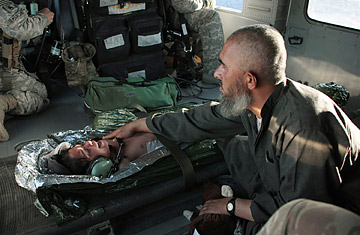
A 7-year-old girl, shot in the back during insurgent attacks in Kandahar on May 7, 2011, cries as her father comforts her in an American medevac helicopter
Taliban fighters carried out a series of coordinated attacks across the embattled southern Afghan city of Kandahar on Saturday — a campaign that Afghan President Hamid Karzai characterized as "revenge" for the death of Osama bin Laden. Insurgents first assaulted the provincial governor's palace with rocket-propelled grenades and small-arms fire and then launched a series of strikes on the headquarters of the Afghan National Police and the Transportation Police, and on Police Sub-station No. 1 as well as various other Afghan National Security Forces and International Security Assistance Force (ISAF) buildings in both Kandahar city and in the Arghandab River Valley, ISAF reported. Between a dozen and two dozen people were wounded in the fighting, Afghan media reported. All of the suicide bombers were killed.
"Al-Qaeda and its terrorist members who have suffered a major defeat with the killing of Osama bin Laden in Pakistani territory have tried to hide this defeat by killing civilians in Kandahar and take their revenge on the innocent people of Afghanistan," Karzai said in a statement. The link between the Kandahar attacks and the death of bin Laden was bolstered by a statement seen on many jihadist websites on Saturday in which the Taliban said "the Islamic Emirate [the Taliban's name for itself] believes the martyrdom of Sheikh Osama bin Laden will give a new impetus to the current jihad against the invaders in this critical phase of jihad. The tides of jihad will gain strength and width. The forthcoming time will prove this both for the friends and the foes." The statement was signed by "the general leadership" of al-Qaeda. But later, Taliban spokesmen insisted that the attacks had been in the works for months, news services reported.
"Initial reports indicate that between three and six suicide bombers were stopped — either detonating prematurely or being killed before they could detonate," said U.S. Marine Corps Major General James B. Laster, ISAF Joint Command Deputy Chief of Staff for Joint Operations, in a press release. ISAF reported that none of the attackers breached the walls of any of the compounds. The fighting began around 1 p.m. local time, when insurgents began firing into Governor Toryalai Wesa's compound. Waves of gunfire could still be heard across the city at 4 p.m. The Pajhwok news agency reported that 20 blasts hit the city over the course of the fighting, including two suicide bombs.
Taliban spokesman Qari Yusuf Ahmadi told Tolo TV News that a number of Taliban fighters had targeted four government buildings in Kandahar city and that they had inflicted casualties on the government side, a statement later denied by the government. In a Tolo video a heavy plume of light gray smoke can be seen rising from the city as helicopters fly overhead and gunfire can be heard chattering in the background. An Afghan army soldier can be seen patrolling the street with an AK-47 at the ready while locals go about their business. Few cars or motor rickshaws can be seen on the normally crowded streets. Most recently, the city was the scene of a Taliban-orchestrated jailbreak that released hundreds of inmates from the city's main prison, including hundreds of fighters. Just days before that, a suicide bomber dressed as a police officer killed General Khan Mohammed Mujahid, the Kandahar provincial police chief.
"This clearly was intended to be a spring offensive spectacular attack," said Laster in the ISAF press release. Indeed, the insurgent group was true to its word, as the coordinated attacks came only a week after the Taliban announced that it was ready to begin the traditional spring fighting season, in an effort to show strength after a winter of losses, observers noted. However, after U.N. statistics were released earlier this year showing that the Taliban was responsible for 75% of civilian deaths in 2010, the group made clear in its statement that it did not intend to harm civilians — seemingly aware of the outrage sparked by the dozens of civilian deaths caused by a string of bombings in February and March. Yet the group warned that "all Afghan people should bear in mind to keep away from gatherings, convoys and centers of the enemy." In the continuing big-picture battle for hearts and minds in Afghanistan, Laster said "the insurgents claimed that they would protect civilians in their spring offensive press release, however, again today they have wounded more civilians."
The announcement last week by the Taliban that it would step up attacks in the coming months coupled with the killing of bin Laden have sparked fears among Afghans and foreigners alike that there will be a major uptick in violence. Bin Laden's death "is an opportunity for the Taliban to step up their activities because there will be more publicity from it. All U.S. forces here and in Iraq should be on a heightened alert. This has increased the likelihood of further attacks," Chris Barry, a civilian investigator with the U.S. Army's Major Crimes Taskforce — a unit responsible for investigating high-level assassinations of Afghan government officials — told TIME the day of bin Laden's death.
In a further warning, Lotfullah Mashal, spokesman for the National Directorate of Security, said at a press conference, "The death of Osama does not mean the end of terrorism, because al-Qaeda is like a spider net spreading over Afghanistan and other countries."
